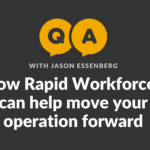
Companies are facing many new challenges this year. As we come out of the worst of the pandemic, operations are faced with a competitive labor pool and supply chain delays in addition to the annual problem of hiring and preparing for peak.
We spoke with Harold Baro, SIMOS’s Senior Vice President, to get his expertise on preparing for peak season and the new challenges facing businesses this year.
What has changed for this upcoming peak season?
This upcoming peak season may be a bit different as the worst of COVID-19 continues to wind down. Workers are going to be more selective about what jobs they take and will most likely want high wages this fall.
Wages have continued to increase more than in previous seasons and many companies will need to start their recruitment plans early this year. With increased volume demand, higher headcount requirements and a tougher labor market, starting early on hiring plans will ensure you attract the right candidates this season.
Because so many companies are paying higher wages, operations should be sure to promote any increases in wages or any peak incentives that may sent them a part. Doing so will also help secure your workforce and reduce turnover during the highest demand window in late November and December.
How far in advance should companies be planning for peak?
Companies should start the planning almost immediately after the prior peak to get ready for the next peak. Those discussions should include what went right during the prior peak and what were the challenges that were faced and how to avoid or improve for the next peak.
It is never too soon to start planning. Certainly, it would be a phased approach where light legwork is done during Q1 and as you move through Q2, meetings become monthly to really start getting the game plan solidified—from operations, to recruiting, to maintenance contingency plans if automation is in the building, to a replenishment plan with heavy spikes in volume as well as an overall onboarding plan to hit the proper headcounts for large volume swings.
It must be a concerted effort by the company as well as their staffing agencies to be properly prepare for what will be needed.
Any forecasting tools should be shared and reviewed to build proper contingency plans. Typically, you should expect the best results, but plan for bumps in the road and how to avoid them or what should be done if you experience one. A good proactive plan will always be more successful than being reactive.
What’s the best way to hire for seasonal workers?
The best way to hire for seasonal workers is to start the market research and advertising open positions a few months prior to the actual need. Many people look for seasonal jobs or additional work, so informing them of what will be available will get your need on the radar sooner than later.
A grass roots recruitment marketing effort will be very beneficial as you get into the community, talk to city hall, churches, community centers and department of labor in the city and neighboring cities to attract talent from a large radius to maximize your labor pool. Use your current associates to get the word out, offer referral bonuses and peak bonuses.
Seasonal workers are typically just looking for that part time job to get a bit more income during the holidays. Create flexible schedules that allow individuals to find the right shift on the right days that work for them. This will create a win-win for both the hiring agency as well as the associate looking for that seasonal work.
What attributes should you be looking for in peak season workers?
Typically, you are looking for folks that are flexible to work unique days or shifts as well as willing to work some overtime as peak times call for extended hours. Look for those that have a positive attitude when applying for the job and are open and honest about what they are willing to be available for.
Ask the associate what they are looking for. You want the opportunity to accommodate them as much as possible t because that will be more successful for the company long term as it will result in less turnover. Make sure there is a culture fit with your company vs. just hiring to fill.
How should operations keep people safe this season?
Operations should continue to enforce the safety protocols that are in place to ensure proper cleaning practices in the workspace.
- Provide hand sanitizer for all as they come in, go to breaks and return from breaks
- Encourage mask use among employees who are not vaccinated
- Make sure workstations or work areas are sanitized prior to a new shift starting, so the next shift can be sure they are walking into a clean environment that has been disinfected
- Stagger shift start times wherever possible to reduce number of people clocking in at the same time and reduce length of check in lines
- Stagger breaks more to reduce the number of people in break rooms and promote social distancing
- Continue to communicate the new regulations around safety and make it clear to employees that they should not come to work if they aren’t feeling well
- Allow a more lenient attendance policy so that employees feel comfortable staying home if they’re feeling sick. Be sure to continue tracking absences because you will see a pattern if someone is abusing the policy and you can address accordingly
What’s the biggest advantage of an output-based staffing model, especially for peak?
The biggest advantage of an output-based staffing model is that it truly aligns your key performance indicators and holds the staffing agency accountable for throughput vs. heads and hours in your building.
It allows you to focus on the overall facility execution, while having your fixed-cost provider focus on hitting your output goals. Rather than worrying about if you have enough heads and if they are productive, your process becomes volume-based. Taking concern away from headcount and therefore allows you to be more strategic—forcing your output-based solution provider to be focused on the execution of that plan.
Fixed cost gives you budget certainty and a better control of your peak costs. During peak, costs can get extremely high if not managed properly because more hours and more heads are put into the building without raising output. Doing this can not only impact your output goals but also raise yours costs.



